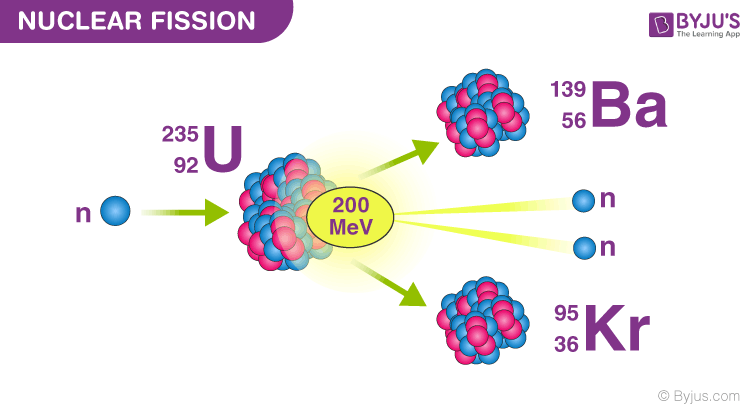There are two types of nuclear reactions called nuclear fission and nuclear fusion. Nuclear fission and fusion involve the disintegration and combination of the elemental nucleus. In the case of nuclear fission, an atom divides into two or more smaller or lighter atoms. Nuclear fusion occurs when two or more atoms join or fuse together to form a large or a heavier atom.
What is Nuclear Fission?
Nuclear fission is a nuclear reaction in which the nucleus of an atom is bombarded with low energy neutrons which split the nucleus into smaller nuclei. An abundant amount of energy is released in this process. Nuclear fission reactions are used in nuclear power reactors since it is easy to control and produces large amounts of energy.

When uranium-235 atoms bombard with neutrons, the heavy nucleus of the uranium splits and produces krypton-94 and barium-139 with the emission of three neutrons.
Read More: Nuclear Fission
What is Nuclear Fusion?
Nuclear Fusion is a reaction that occurs when two atoms combine together to form one or more different atomic nuclei and subatomic particles like protons and neutrons. An enormous amount of energy is released in this process, much greater than the energy released during the nuclear fission reaction.

Fusion occurs in the sun where the atoms of(isotopes of hydrogen, Hydrogen-3, and Hydrogen-2) Deuterium and Tritium combine in a huge pressure atmosphere with extremely high temperatures to produce an output in the form of a neutron and an isotope of Helium. Also, the amount of energy released in fusion is way greater than the energy produced by fission.
Read More: Nuclear Fusion
Nuclear Fission vs Nuclear Fusion
The table below lists the various differences between nuclear fission and fusion:
|
Nuclear Fission |
Nuclear Fusion |
|
When the nucleus of an atom splits into lighter nuclei through a nuclear reaction the process is termed nuclear fission. |
Nuclear fusion is a reaction through which two or more light nuclei collide with each other to form a heavier nucleus. |
|
When each atom split, a tremendous amount of energy is released |
The energy released during nuclear fusion is several times greater than the energy released during nuclear fusion. |
|
Fission reactions do not occur in nature naturally |
Fusion reactions occur in stars and the sun |
|
Little energy is needed to split an atom in a fission reaction |
High energy is needed to bring fuse two or more atoms together in a fusion reaction |
|
Atomic bomb works on the principle of nuclear fission |
Hydrogen bomb works on the principle of a nuclear fusion bomb. |
The table above would have given you a clear idea about how the two terms nuclear fission and fusion vary from one another.
|
Similar Reading: |
Stay tuned with BYJU’S for more such interesting articles. Also, register to “BYJU’S – The Learning App” for loads of interactive, engaging Physics-related videos and unlimited academic assist.




This is an amazing way to teach the students in this lock down. Wow ????
I really appreciate your for your way of teaching
Uh r doing a great job.